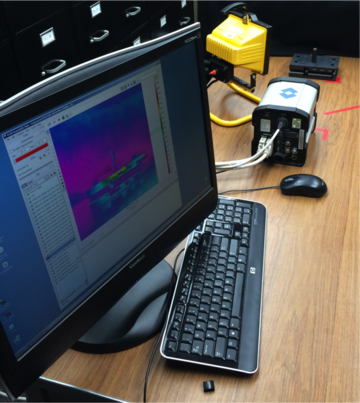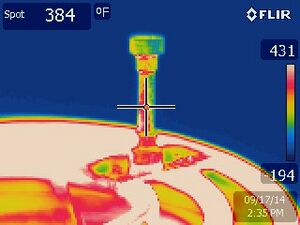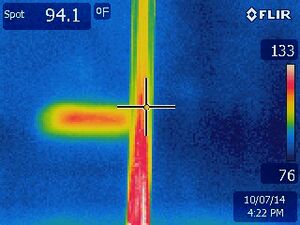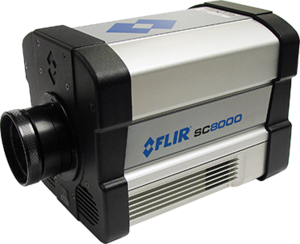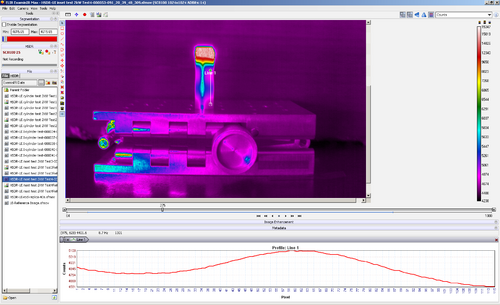Our client, Idaho National Laboratory (INL), proposed the design project for "Dimensional Inspection and Defect Identification for Nuclear Fuels". The goal of this project is to create a test bench that facilitates the inspection of irradiated nuclear fuel rods, identifying and characterizing external as well as internal defects. The two primary methods to be used for this inspection are thermal imaging and optical profilometry.
Problem Definition
Background
INL has been performing safety testing on nuclear fuels for many years, as can be seen in the SPERT Tests Summary. The outcome of the testing is that the fuel rods are often damaged, sometimes severely and sometimes only subtly. When the damage is particularly subtle, it can at times be difficult to detect with a purely visual inspection. As such, a reliable method of defect detection in the fuel rods is needed.
Design Goals
- Detect defects in micro nuclear fuel rods (rodlets) utilizing thermal (infrared) imaging and optical (non-contact) profilometry
- Integrate all testing equipment into a test bench
- Design and develop an efficient and effective method to present the data gathered
- Provide ample documention of the design process and methodology of test bench use
Design Specifications
| Features
|
- Material handling method for fuel rods from transfer port to storage
- Develop a data processing method for combining profilometer and thermal data
- Develop a user-friendly interface for a glovebox environment
- Design for controlled manipulation of the specimen
- Prevent contamination by design for easy cleaning
|
| Constraints
|
- Footprint less than 24" x 18"
- Wiring must feed through existing glovebox plugs
- Use only 110 V power
- Weigh less than 30 lbs and include a hook for moving/storage
- FLIR mounting system shielding camera from radiation
|
| Standards
|
- Detect ovality in specimens within a tolerance limit (geometrically)
- Detect radial as well as axial cracks within a tolerance limit (both geometrically and thermally)
- Detect failures in the end caps and welds (both geometrically and thermally)
|
Project Learning
- Preliminary thermal camera testing:
- We learned that heat tends to flow toward towards the regions where stress concentrations would occur.
- Further investigation:
- Differential heating due to internal geometries can be resolved through a thin-walled tube such as the ones the fuel rods utilize.
|
|
FLIR test image.
Notice the heat collection at stress concentration points.
|
|
|
FLIR test image with hollow tube specimen.
|

|
FLIR footage, slowed down from real-time.
Asymmetrical heating attributable to a void space in internal geometry can be observed.
|
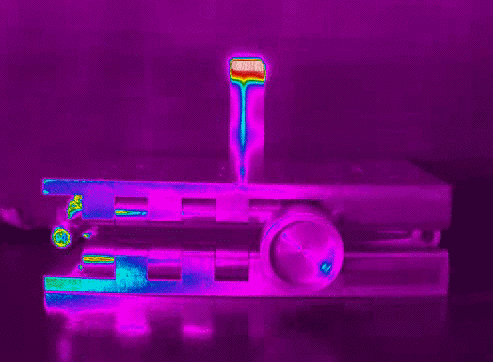
|
FLIR footage, slightly slowed from real-time.
Secondary thermal contact point can be observed further down from the primary point of contact at the top.
|

|
Sped-up FLIR footage of a SPERT rod being heated by halogen lamps, then cooling down, all over a period of several minutes.
The end cap can be seen to take much longer to warm up when heated, and cools down much more slowly as well. This is because the end cap is solid while the remainder of the fuel rod is hollow, thus the cap has a much larger thermal inertia.
|
Design
Process Diagram
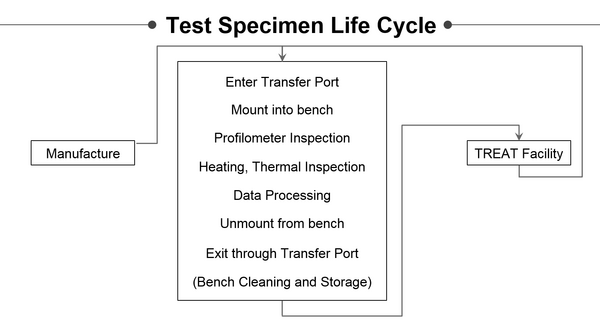
Test specimen process flow chart.
Optical Profilometers
| Model |
Advantages |
Disadvantages
|
| Novacam
|
- Small form factor
- Radiation tolerant
- Fast scanning time
|
- 1 μm finest resolution
- Less flexible export formats
|
| Nanovea
|
- 0.9 μm XY- & 1 nm Z-resolution
|
- Higher cost
- Slightly larger form factor
|
We have concluded that the Novacam is the more flexible alternative, and have recommended it for purchase.
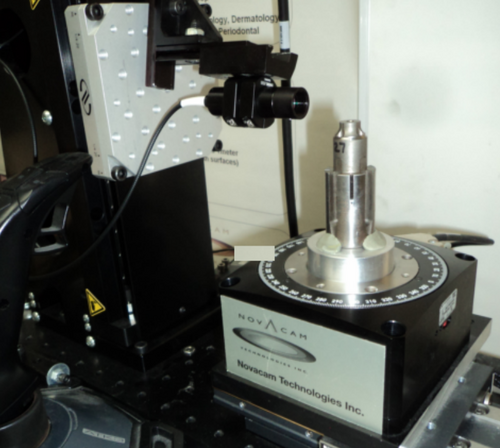
Novacam profilometry setup.
Technology and Software
|
|
FLIR SC8000 infrared camera.
INL graciously loaned us the use of their camera, a FLIR SC8000 model. It features a 1024x1024 pixel count, very high frame rates (greater than 120 Hz), and high accuracy.
This vastly improved our infrared capabilities, as the University's handheld E-series FLIR camera had no video capability and only had a resolution of 320x240 pixels, so upgrading cameras increased our pixel count by a factor of 13.7.
|
|
|
FLIR software.
The ExaminIR software shown here takes the data collected by the FLIR camera - namely photon counts from the CCD - and processes them for display in an image format. Various palettes can be chosen to map the photon count per pixel to a color. The palette shown here is a "rainbow" where lower photon counts are black/pink and higher photon counts progress through blue, green, yellow, then finally red as can be seen at the right.
A line or other 2D profile can also be drawn and the photon counts across the profile graphed out, as can be seen at bottom.
|
Team Information
| Picture |
Bio |
Discipline
|
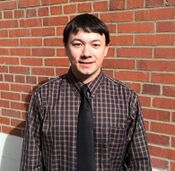 |
Iain Fisher:
Iain is a senior at the University of Idaho and plans to graduate with Bachelor degrees in Mechanical Engineering and Applied Physics in May of 2015. After graduation he plans to pursue employment in aerospace, optical, and/or firearms engineering. Outside of coursework, Iain can often be found working at his parents' optical engineering business, hunting, target shooting, singing in choir, or contributing to open-source game development.
His team responsibilities include team website and budget management.
|
Mechanical Engineering
|
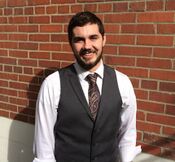 |
Kaleb Trotter:
Kaleb is a mechanical engineering senior at the University of Idaho. He plans to study nuclear engineering at the graduate level with a focus on nuclear fusion reactor design and physics. He works as a web developer in Moscow at an economic modeling firm. When not doing either of those things he gets to hang out with his lovely wife and son, possibly watching college football. He enjoys watching sports with friends, hanging out with family, choral singing, Sunday afternoon football, and rugby. His responsibilities on the design team include team organization.
|
Mechanical Engineering
|
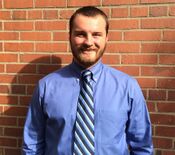 |
Trevor Lutz:
Trevor is a Senior in Mechanical Engineering at the University of Idaho. He actively participates in multiple clubs and on multiple design teams at the University including the Clean Snowmobile Challenge team where he has held the title of Sound Expert, and the Formula Hybrid Society of Automotive Engineering team where he is assisting with the redesign on a single cylinder intake to help with volumetric efficiency. He is an active member of the Beta Theta Pi Fraternity and a Fourth year Engineering Scholar. He enjoys hunting, fishing, riding snowmobiles, exploring the outdoors, lifting weights, running and spending time with friends and family. Post-graduation he would like to continue his education in the form of pursuing his Professional Engineering Certification, a Master's Degree in Engineering, or a Master's Degree in Business. His primary responsibility for the team is to act as a liaison and client contact for all team progress, milestones, and continued communication.
|
Mechanical Engineering
|
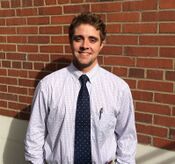 |
Cristofer Farnetti:
Cristofer is a senior of mechanical engineering at the University of Idaho. After his Bachelor degree is completed in mechanical engineering, he plans to pursue a career in either the automotive engineering industry, or the nuclear industry. Once he's served several years in industry, he plans to go to graduate school and obtain his Masters in mechanical engineering. Outside of academia and work, he spends his time giving back to the community of Moscow, Idaho by doing community service, and raising funds for charities. Recreationally, he likes to spend his time hiking, fishing, hunting, and researching the latest automotive designs. His responsibilities on the team are to maintain the portfolio, and document the progress that the team makes.
|
Mechanical Engineering
|
Documents Archive
Meeting Minutes
Other
Project Timeline
INL SPERT Tests Summary
Profilometer Research Summary
Team Contract
Design Review (November 21, 2014)
2015 Expo Technical Presentation
